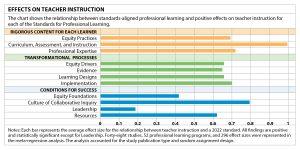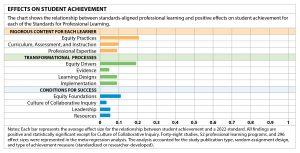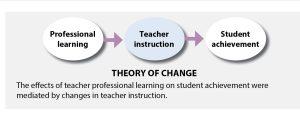RESEARCH
Study links standards with teacher and student outcomes
By Rachel Garrett, Qi Zhang, Martyna Citkowicz and Lauren Burr
Categories: Research, Standards for Professional LearningJune 2022
When Learning Forward approached the Center on Great Teachers and Leaders at the American Institutes for Research about partnering on a research review for Standards for Professional Learning, we jumped at the chance. We were excited to apply our expertise in research methods to help build the field’s knowledge about how educators’ professional learning contributes to student success.
As we began to plan for a systematic literature search and review of randomized field studies published since the release of the 2011 standards, we saw an opportunity to add depth to the project by conducting a meta-analysis. A meta-analysis is a rigorous statistical procedure to summarize quantitative findings across multiple studies.
Meta-analysis is a powerful approach because it examines whether two variables appear to be related to each other not just in one sample of data but in many samples with different participants and in different locations. When a meta-analysis finds a positive effect across studies, it provides more robust evidence than one study alone. And unlike a literature review, it provides a measurable effect that can be compared to the effects of other types of interventions. This can be helpful for making decisions about how to invest resources and time.
For a larger image of this graph, download the pdf of this article.

The goal of our meta-analysis was to examine whether there is a significant relationship between professional learning that is aligned to Standards for Professional Learning and teacher instruction and student achievement. Using a cutting-edge method called a mediation-meta-analysis, we were also able to examine whether changes in teacher instruction brought about by professional learning lead, in turn, to changes in student achievement.
How well did the studies align with the standards?
After identifying studies appropriate for inclusion in the meta-analysis, our next step was to examine the professional learning programs in the studies. Specifically, we wanted to know how well the programs aligned with the 2022 standards. We developed criteria and coded the programs according to whether they aligned with each of the 11 standards.
We found varying levels of representation of different standards. The standards most commonly represented were Professional Expertise (32 out of 48 studies) and Learning Designs (28 out of 48 studies). Only a limited number of studies provided evidence of alignment with the three equity standards or the Leadership standard.
Examining the three frames in Standards for Professional Learning, the professional learning described in the studies was less often aligned with the Conditions for Success frame compared to the other frames (Rigorous Content for Each Learner and Transformational Processes). In light of the paucity of studies meeting the Leadership, Equity Drivers, and Equity Practices standards, we interpret all analyses of these standards with caution.
Was standards-aligned professional learning linked to teacher and student outcomes?
Next, we looked at how standards-aligned professional learning was associated with teacher instruction and student achievement outcomes, examining each standard separately. The analyses indicated that alignment with the 2022 Standards for Professional Learning was associated with large, positive average effects on instruction. (See graphic above.) Among the statistically significant effects, the average effects on instruction ranged from moderate in size (Equity Foundations) to large (Curriculum, Assessment, and Instruction).
The findings were similar when considering student achievement. Analyses indicated modest but positive average effects for student achievement across all of the 2022 standards. (See graphic below.) Among the statistically significant findings, average effects ranged from modest in size (among each of the Leadership, Resources, and Evidence standards) to more moderate (Equity Practices).
Do changes in instruction lead to changes in student achievement?
Underlying Standards for Professional Learning — and most professional learning practice — is a theory of change that predicts professional learning will benefit teacher instruction and, in turn, student achievement outcomes. In other words, student achievement improves, at least in part, through the instructional improvements.
For a larger image of this graph, download the pdf of this article.

Although this theory of change applies to virtually all professional learning studies, research has provided limited information to empirically test it. Our mediation-meta-analysis addressed this gap in the literature. It used all available information across the studies to understand the effects that teacher professional learning has on student achievement and how those effects may be attributed to changes in teacher instruction.
The analyses supported the theory of change, as shown in the figure above. First, improvements in instruction were positively and significantly associated with improvements in student achievement. Second, improvements in student achievement were explained through the improvements in teacher instruction that came from the professional learning.
What next?
The findings of our meta-analysis consistently indicate that evidence of program alignment with Standards for Professional Learning is associated with improved teacher instruction and student achievement. By extension, they suggest that investments in high-quality professional learning can yield meaningful improvements in student achievement.
The study also highlighted the opportunity for future investigations that will add even more knowledge to the professional learning field. For example, randomized field research offers limited understanding about the broader systems and contexts in which professional learning is tested. Expanding that research can help leaders determine what kinds of professional learning to implement, where, and when.

The current findings, and those from studies we hope will build on this one, can make important contributions to the field that will support the efforts of professional learning leaders and advocates to bolster high-quality professional learning for all educators.
Categories: Research, Standards for Professional Learning
Recent Issues
WHERE TECHNOLOGY CAN TAKE US
April 2024
Technology is both a topic and a tool for professional learning. This...
EVALUATING PROFESSIONAL LEARNING
February 2024
How do you know your professional learning is working? This issue digs...
TAKING THE NEXT STEP
December 2023
Professional learning can open up new roles and challenges and help...
REACHING ALL LEARNERS
October 2023
Both special education and general education teachers need support to help...













